How to tell if a watermelon has gone bad? In recent years, the number of poisonings from this large berry has increased. This may be due to the use of nitrates to accelerate growth, as well as incorrect determination of ripeness and freshness. In this article, we’ll explore whether you can eat a watermelon that has started to spoil and how to identify signs of rot.
Table of contents
How to know if a watermelon has spoiled
To avoid unpleasant consequences from eating spoiled watermelon, it’s important to know what a healthy fruit should look like. You can determine this by both external signs and taste.
External signs
First, assess the fruit’s appearance. The watermelon should not have dents, deep scratches, or other damage. The rind should be dark green or striped, without any brown or black spots. The exception is the yellow ground spot, which forms where the watermelon rested on the soil during ripening.
A fuzzy coating signals possible spoilage — mold contamination. The coating can vary in colour depending on the type of mold.
The stem attachment point should be dry and firm. If it yields under finger pressure, the entire watermelon is likely rotten inside.
The freshness of the fruit can be confirmed after cutting it open. Healthy flesh is red or pinkish. There are also special varieties with yellow or orange flesh. If the watermelon has uneven colouring, it’s a clear sign of spoilage. Dry flesh with tough veins that separate from the seeds also indicates staleness, as does overly soft or mushy texture.
Before cutting the watermelon, shake it. If you hear a sloshing sound inside, the fruit has gone bad.
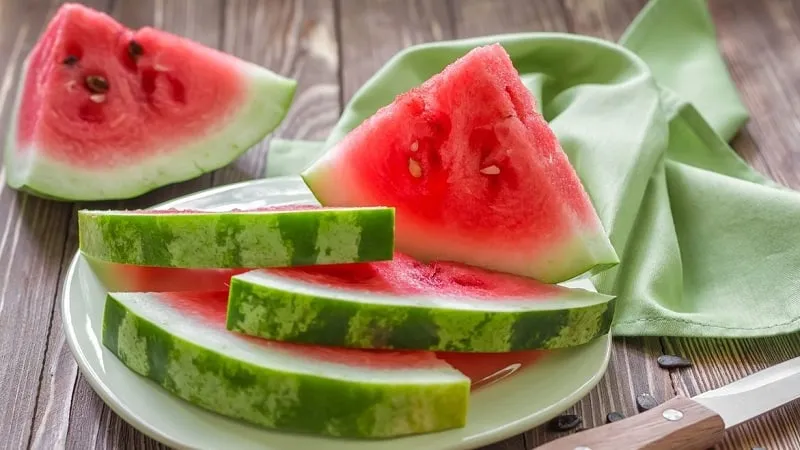
Checking freshness by date
If you bought a pre-packaged watermelon in a supermarket, check the label. Do not consume berries past their expiration date.
Taste and smell
Even an uncut fruit emits a light, pleasant aroma. If you detect a sour or bitter smell, the fruit has fermented. A wine-like or yeasty odour also indicates spoilage.
A spoiled watermelon will taste unpleasantly sour, with sticky flesh.
Signs of a spoiled watermelon
If you notice any of the following signs, carefully inspect the fruit for others.
Signs of a rotten watermelon:
- sloshing sound when shaken;
- yellow, grey, brown, or black spots (excluding the ground spot);
- fuzzy mold on the rind;
- soft stem attachment point;
- soft dents on the surface;
- unpleasant sour or bitter smell and taste;
- sticky flesh;
- tough veins;
- discoloured flesh;
- hollow spaces around seeds.
To avoid buying a spoiled fruit, inspect it before purchasing.
Sometimes a watermelon looks fine externally but is rotten inside. This often happens due to improper or prolonged storage. Nitrates can also cause rapid internal spoilage.

Can you eat a watermelon that has started to spoil?
Eating a fermented watermelon is not advisable, but you can use it to make homemade wine or a unique dessert.
If only small sections are affected, you can cut them out. Do so with a generous margin and ensure the rest of the flesh is healthy. However, children should not consume such fruit.
Risks of eating spoiled watermelon
Consuming spoiled watermelon can lead to poisoning. Symptoms appear within 2–6 hours and include:
- weakness;
- fever;
- nausea, vomiting;
- diarrhoea;
- stomach pain;
- dizziness, sometimes headaches.
More severe symptoms — such as heart irregularities or fainting — may also occur.
Note. Poisoning can result not only from improper storage but also from nitrate contamination. In the human body, nitrates convert into toxic nitrites.
Another cause of poisoning is poorly washed fruit. Always rinse watermelons thoroughly before cutting.
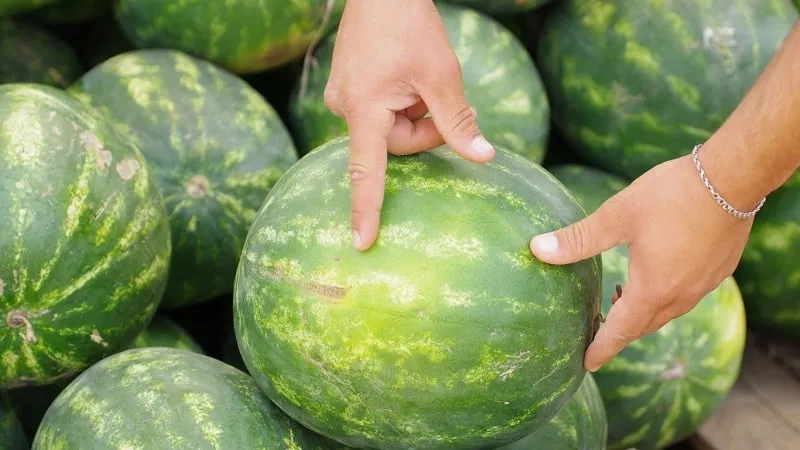
First aid
If poisoning occurs, follow these steps: rinse the stomach and take activated charcoal or other absorbents like Smecta.
To rinse the stomach at home:
- Prepare 1 litre of room-temperature water.
- Drink it quickly.
- This will trigger vomiting, expelling stomach contents.
Repeat the process 2–3 times if needed.
Important. Children under 3 should not undergo home stomach rinsing due to underdeveloped reflexes. They could choke on vomit. Only medical professionals should perform this procedure on young children.
Afterwards, drink plenty of water to flush out toxins and prevent dehydration.
Even after these steps, the condition may worsen — ensure someone stays with the affected person until medical help arrives.
Avoid painkillers and anti-diarrhoea medications like Imodium. They mask symptoms but don’t address the root cause.
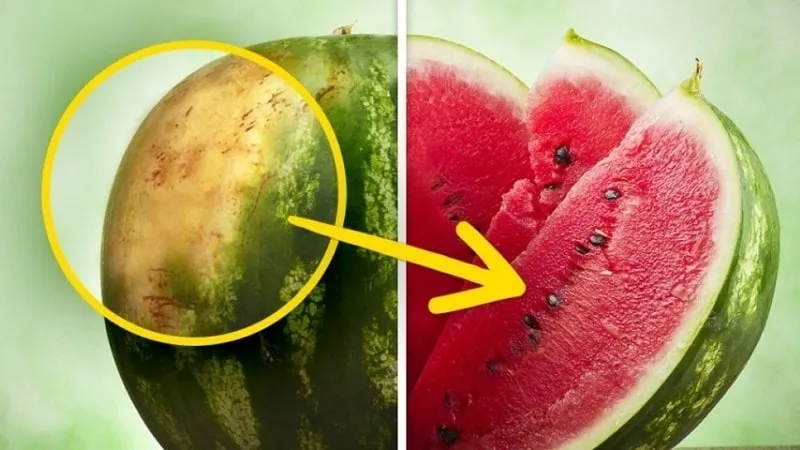
Storage duration and conditions
Whole watermelons last 1–2 weeks at room temperature and 3–4 weeks refrigerated.
Tip. Extend shelf life by washing, drying, and hanging small watermelons (under 4 kg) in a net in a cool place.
Cut watermelon spoils much faster. Refrigerated, it lasts 2–3 days. At near-freezing temperatures — up to 5 days. This assumes the fruit wasn’t left cut at room temperature for long. Store slices in an airtight container.
Freezing is not recommended. When thawed, most juice will leak out, altering taste and texture.
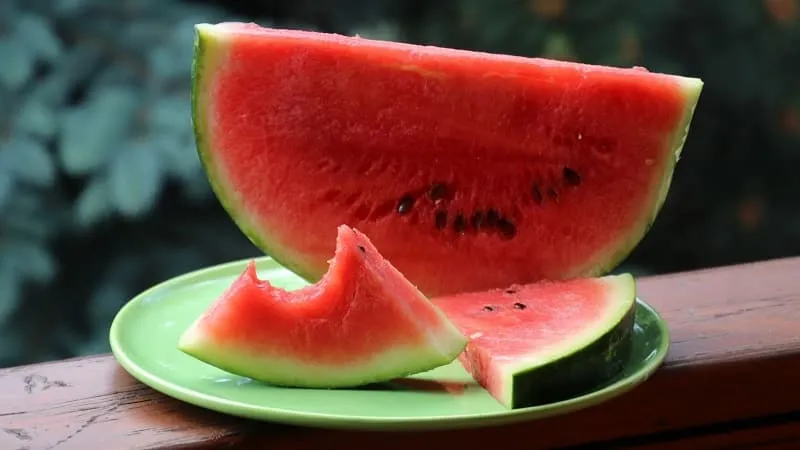
What to make with overripe watermelons
Overripe watermelons need not be wasted. Use intact fruits (no cracks or splits) to create delicious dishes. Damaged watermelons undergo harmful lactic fermentation.
"Tipsy Watermelon" Dessert
A unique cake with a hint of wine and fruity flavour.
Ingredients:
- 1 watermelon (max 5 kg);
- 500 g ready-made puff pastry;
- 150 g sugar;
- 1.5 cups dry white wine;
- 1 cup cream;
- 1 lemon;
- 40 g gelatin;
- 100 g icing sugar.
Preparation:
- Wash the lemon, juice it, and grate the zest.
- Roll out half the pastry to fit a baking dish.
- Cut the remaining pastry into squares, then shape into triangles on a separate tray.
- Cube the watermelon flesh and arrange it over the pastry.
- Bake both pastry layers at 180°C until golden.
- Mix wine, lemon juice, sugar, and gelatin in a bowl.
- Simmer for 5 minutes, stirring constantly.
- Cool the mixture.
- Pour the gelatin-wine mix over the baked pastry base.
- Refrigerate for 2–3 hours.
- Carefully remove the cake from the dish.
- Whip cream with icing sugar.
- Spread over the cake.
- Top with pastry triangles and lemon zest.
Homemade Watermelon Wine
This recipe uses pressed yeast, but wine yeast works too.
Ingredients:
- 25 kg seedless watermelon flesh;
- 50 g pressed yeast;
- 2.5 kg sugar.
Preparation:
- Strain the flesh through a sieve.
- Mix the puree with sugar and let sit for 30 minutes.
- Stir until sugar dissolves completely.
- Dissolve yeast in warm water.
- Combine with the puree.
- Transfer to a fermentation vessel. Fit with an airlock or punctured glove.
- Store in a dark place for 5–7 days.
- Strain the liquid.
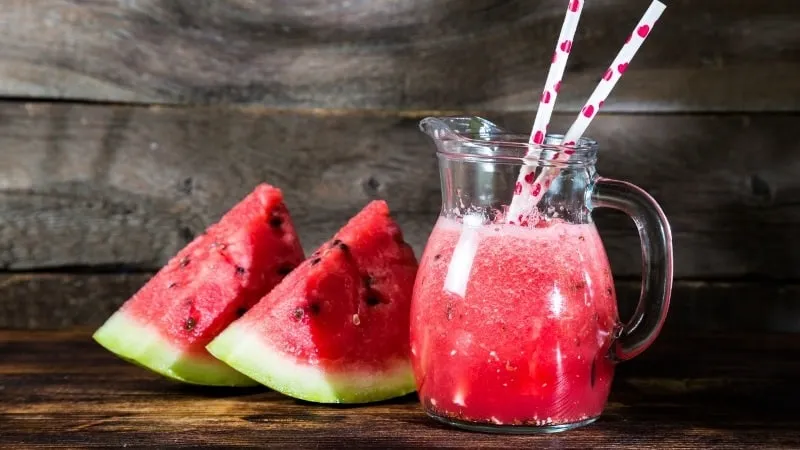
Conclusion
A spoiled watermelon doesn’t have to be discarded. With effort, it can become a tasty dessert or drink — safe for adults after processing. Never eat rotten watermelon raw, as it may cause severe poisoning.







